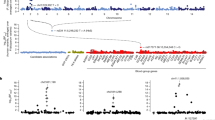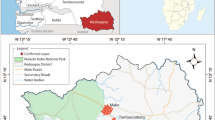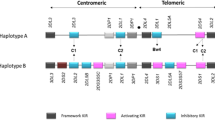Abstract
CD40 ligand (CD40L), a glycoprotein involved in B cell proliferation, antigen presenting cell activation, and Ig class switching, is important in the immune response to infection. Rare coding mutations in CD40L can lead to life-threatening immunodeficiency but the potential for common variants to alter disease susceptibility remains to be explored. To identify polymorphisms in CD40L, we sequenced 2.3 kb of the 5′ flanking region and the first exon of the gene in DNA samples from 36 Gambian females and one chimpanzee. Diversity was lower than the average reported for other areas of the X chromosome, and only two polymorphisms were identified. The polymorphisms were genotyped in DNA samples from 957 Gambian individuals, cases and controls from a study of severe malaria. A significant reduction in risk for severe malaria (OR = 0.52, P = 0.002) was associated with males hemizygous for the CD40L−726C. Analysis by transmission disequilibrium test of 371 cases, for whom DNA from both parents was also available, confirmed the result was not due to stratification (P = 0.04). A similar but non-significant trend was found in females. This preliminary association of a common variant in CD40L with a malaria resistance phenotype encourages further genetic characterization of the role of CD40L in infectious disease.
This is a preview of subscription content, access via your institution
Access options
Subscribe to this journal
Receive 6 digital issues and online access to articles
$119.00 per year
only $19.83 per issue
Buy this article
- Purchase on Springer Link
- Instant access to full article PDF
Prices may be subject to local taxes which are calculated during checkout

Similar content being viewed by others
References
Durie FH, Foy TM, Masters SR, Laman JD, Noelle RJ . The role of CD40 in the regulation of humoral and cell-mediated immunity Immunol Today 1994 15: 406–411
Notarangelo LD, Duse M, Ugazio AG . Immunodeficiency with hyper-IgM (HIM) Immunodefic Rev 1992 3: 101–121
Levy J, Espanol-Boren T, Thomas C et al. Clinical spectrum of X-linked hyper-IgM syndrome J Pediatr 1997 131: 47–54
Gauchat JF, Henchoz S, Fattah D et al. CD40 ligand is functionally expressed on human eosinophils Eur J Immunol 1995 25: 863–865
Grammer AC, Bergman MC, Miura Y, Fujita K, Davis LS, Lipsky PE . The CD40 ligand expressed by human B cells costimulates B cell responses J Immunol 1995 154: 4996–5010
Pinchuk LM, Klaus SJ, Magaletti DM, Pinchuk GV, Norsen JP, Clark EA . Functional CD40 ligand expressed by human blood dendritic cells is up-regulated by CD40 ligation J Immunol 1996 157: 4363–4370
Kornbluth RS . The emerging role of CD40 ligand in HIV infection J Leukoc Biol 2000 68: 373–382
Hill AV . The immunogenetics of resistance to malaria Proc Assoc Am Physicians 1999 111: 272–277
McGuire W, Hill AV, Allsopp CE, Greenwood BM, Kwiatkowski D . Variation in the TNF-alpha promoter region associated with susceptibility to cerebral malaria Nature 1994 371: 508–510
Hill AV, Elvin J, Willis AC et al. Molecular analysis of the association of HLA-B53 and resistance to severe malaria Nature 1992 360: 434–439
Kwiatkowski D . Genetic susceptibility to malaria getting complex Curr Opin Genet Dev 2000 10: 320–324
Karpusas M, Hsu YM, Wang JH et al. 2 A crystal structure of an extracellular fragment of human CD40 ligand Structure 1995 3: 1426
Miller RD, Taillon-Miller P, Kwok PY . Regions of low single-nucleotide polymorphism incidence in human and orangutan Xq: deserts and recent coalescences Genomics 2001 71: 78–88
Shimadzu M, Nunoi H, Terasaki H et al. Structural organization of the gene for CD40 ligand: molecular analysis for diagnosis of X-linked hyper-IgM syndrome Biochim Biophys Acta 1995 1260: 67–72
van Kooten C, Banchereau J . CD40-CD40 ligand J Leukoc Biol 2000 67: 2–17
Tsytsykova AV, Tsitsikov EN, Geha RS . The CD40L promoter contains nuclear factor of activated T cells-binding motifs which require AP-1 binding for activation of transcription J Biol Chem 1996 271: 3763–3770
Quandt K, Frech K, Karas H, Wingender E, Werner T . MatInd and MatInspector: new fast and versatile tools for detection of consensus matches in nucleotide sequence data Nucleic Acids Res 1995 23: 4878–4884
Hartl DL, Clark AG . Principles of Population Genetics. 3rd edn Sinauer Associates: Sunderland, Mass 1997
Anagnostopoulos T, Green PM, Rowley G, Lewis CM, Giannelli F . DNA variation in a 5-Mb region of the X chromosome and estimates of sex-specific/type-specific mutation rates Am J Hum Genet 1999 64: 508–517
Cargill M, Altshuler D, Ireland J et al. Characterization of single-nucleotide polymorphisms in coding regions of human genes [published erratum appears in Nat Genet 1999; 23: 373] Nat Genet 1999 22: 231–238
Dean AG, Dean JA, Burton AH, Dicker RC . Epi Info: a general-purpose microcomputer program for public health information systems Am J Prev Med 1991 7: 178–182
Spielman RS, McGinnis RE, Ewens WJ . Transmission test for linkage disequilibrium: the insulin gene region and insulin-dependent diabetes mellitus (IDDM) Am J Hum Genet 1993 52: 506–516
Schaid DJ . Transmission disequilibrium, family controls, and great expectations Am J Hum Genet 1998 63: 935–941
Lander ES, Schork NJ . Genetic dissection of complex traits Science 1994 265: 2037–2048
Kutsche K, Yntema H, Brandt A et al. Mutations in ARHGEF6, encoding a guanine nucleotide exchange factor for Rho GTPases, in patients with X-linked mental retardation Nat Genet 2000 26: 247–250
Li W-H . Molecular Evolution Sinauer Associates: Sunderland, Mass 1997
Lewontin RC . The interaction of selection and linkage. I.General considerations; heterotic models Genetics 1964 49: 49–67
Acknowledgements
We thank David Reich, Shiv Pillai and Joel Hirschorn for many thoughtful discussions and comments and Nick Mundy for the chimpanzee DNA sample. This study would not have been possible without the kind cooperation of the families studied, and the doctors and nurses of RVH, Banjul, The Gambia.
Author information
Authors and Affiliations
Corresponding author
Additional information
This study was funded by the Medical Research Council and the Rhodes Scholarship Trust.
Rights and permissions
About this article
Cite this article
Sabeti, P., Usen, S., Farhadian, S. et al. CD40L association with protection from severe malaria. Genes Immun 3, 286–291 (2002). https://doi.org/10.1038/sj.gene.6363877
Received:
Revised:
Accepted:
Published:
Issue Date:
DOI: https://doi.org/10.1038/sj.gene.6363877
Keywords
This article is cited by
-
Innate sensing of malaria parasites
Nature Reviews Immunology (2014)
-
Reappraisal of known malaria resistance loci in a large multicenter study
Nature Genetics (2014)
-
The complexities of malaria disease manifestations with a focus on asymptomatic malaria
Malaria Journal (2012)
-
Genetic polymorphisms linked to susceptibility to malaria
Malaria Journal (2011)
-
Individual and epistatic effects of genetic polymorphisms of B-cell co-stimulatory molecules on susceptibility to pemphigus foliaceus
Genes & Immunity (2009)



